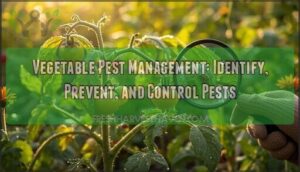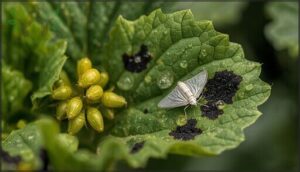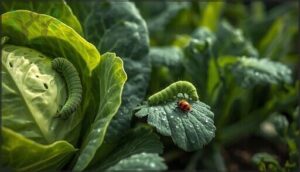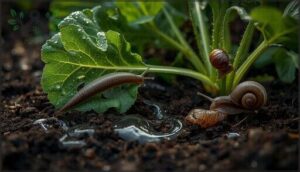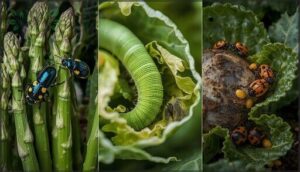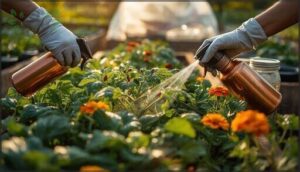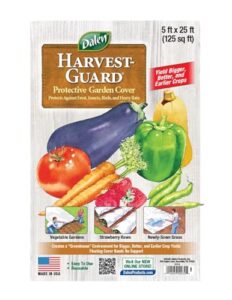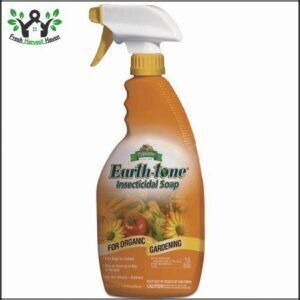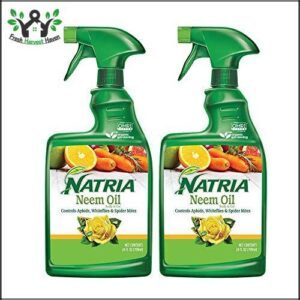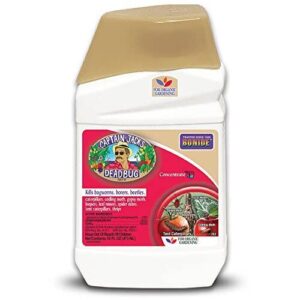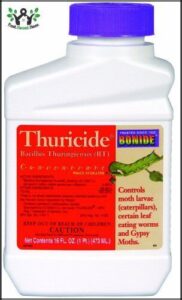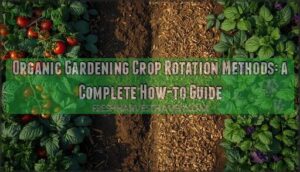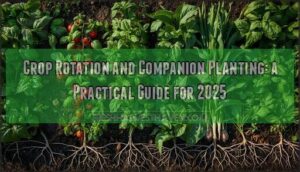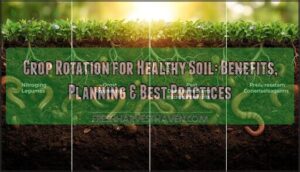This site is supported by our readers. We may earn a commission, at no cost to you, if you purchase through links.
You step into your garden one morning, and the tomato plants that looked perfect yesterday now sport curled, yellowing leaves. Upon closer inspection, you spot clusters of tiny insects and a sticky film coating the stems. This scenario plays out in vegetable gardens everywhere, often catching growers off guard.
Effective vegetable pest management starts with recognizing the early warning signs and understanding how different pests operate. Aphids, beetles, caterpillars, and other common invaders each leave distinct calling cards, and learning to read these signals means you can take action before minor problems spiral into crop losses.
The good news is that combining preventive strategies with targeted organic controls gives you multiple tools to protect your harvest without relying on harsh chemicals.
Table Of Contents
- Key Takeaways
- Identifying Common Vegetable Garden Pests
- Preventing and Managing Pest Infestations
- Organic and Integrated Pest Control Methods
- Top 5 Products for Vegetable Pest Management
- Frequently Asked Questions (FAQs)
- What is vegetable garden pest control?
- How do you control pests in a vegetable garden?
- Are there pests in a vegetable garden?
- Which pest control oil should I use for my vegetable garden?
- How do you control insect damage in a vegetable harvest?
- How do you keep cucumber beetles off a vegetable garden?
- What is the best pest control for vegetables?
- What is the safest repellent for vegetable garden?
- How to get bugs out of fresh vegetables?
- How often should vegetables be inspected for pests?
- Conclusion
Key Takeaways
- You’ll control most vegetable garden pests by combining preventive tactics like crop rotation and row covers with early detection through weekly scouting, keeping damage below economic thresholds without relying solely on sprays.
- Organic controls like insecticidal soap, neem oil, Bt, and spinosad each target different pest types effectively when you rotate them to prevent resistance and time applications during active pest feeding stages.
- Physical barriers such as floating row covers can block insects completely while boosting yields up to 17%, but you must remove them before crops overheat or need pollination.
- Regular monitoring using consistent sampling patterns and action thresholds lets you intervene only when pest numbers justify treatment, cutting spray use by 56–89% while maintaining healthy harvests.
Identifying Common Vegetable Garden Pests
Knowing what’s eating your vegetables is the first step toward protecting your garden. Different pests leave different clues—from the tiny insects clustering on leaves to the larger bugs that chew through stems and foliage.
Let’s walk through the most common culprits you’re likely to encounter so you can identify them quickly and take action.
Recognizing Aphids and Whiteflies
Aphids and whiteflies are among the most common insect pests you’ll encounter in your vegetable garden. Aphids measure 1.5–4 mm in length and appear pear-shaped with long antennae, while whiteflies are tiny moth-like insects about 1–2 mm long with powdery white wings. Both feed by sucking plant juices, causing leaves to yellow and curl. Aphids are a diverse family and can be managed using similar control tactics.
Key identification features include:
- Aphid morphology: Pear-shaped bodies in yellow, green, pink, red, brown, gray, or black, with two tube-like cornicles at the rear
- Whitefly lifecycle: Adults lay 150+ eggs on leaf undersides; nymphs appear as translucent, scale-like forms that stay in one place
- Feeding damage: Distorted shoots, curled leaves, and reduced plant vigor from piercing-sucking mouthparts in phloem tissues
- Honeydew indicators: Sticky residue and black sooty mold on leaves signal heavy infestation and potential virus transmission
Spotting Caterpillars and Beetles
Beyond sap-sucking insects, chewing pests like caterpillars and beetles can strip foliage fast. Imported cabbageworm larvae appear velvety green along leaf veins, while cabbage loopers move in distinctive loops and diamondback moth caterpillars wriggle away when touched. Flea beetles leave tiny shot-hole patterns on leaves, and Colorado potato beetle adults show ten black stripes on orange wing covers.
Scout your plants regularly—examining undersides for larvae and counting feeding holes helps you catch outbreaks before defoliation exceeds 30%. To protect cruciferous crops, consider using row covers early in the season.
Identifying Slugs, Snails, and Cutworms
When you see ragged holes in leaves and slime trails glistening on soil, slugs and snails are likely feeding. Slugs are soft-bodied, reaching one to three inches long, while snails carry that distinctive spiral shell. Both prefer nocturnal feeding in moist conditions.
Cutworms—smooth, gray or brown larvae about an inch long—hide in soil by day, then emerge at night to sever young seedlings right at the stem base.
Detecting Asparagus Beetle, Cabbage Worm, Potato Beetle
Three pests demand your close attention. Asparagus beetles—metallic blue-black with cream spots—lay dark oval eggs on spears; treat when 20% of spears show eggs or 50–75% bear larvae.
Cabbage worms are velvety green caterpillars hiding on leaf undersides; scout every five plants for early pest detection.
Colorado potato beetles deposit bright yellow egg masses; thresholds call for action at roughly 200 small larvae per 50 plants.
- Check asparagus spears for dark eggs standing upright
- Flip brassica leaves to spot green cabbage worms
- Inspect potato foliage undersides for orange egg clusters
- Monitor for larval feeding damage and staining
Noting Carrot Rust Fly and Other Key Pests
Among the sneakiest vegetable garden pests, carrot rust fly deserves your vigilance. Place orange sticky traps at canopy height along field edges, checking weekly once seedlings emerge. When you catch 0.1 flies per trap per day, act fast—larvae tunnel through roots and stunt growth.
Root maggot control and cultural management matter too: rotate carrots 1,000 meters from last year’s plot, and watch for flea beetle damage on early seedlings.
Preventing and Managing Pest Infestations
Stopping pests before they take hold is far easier than fighting a full-blown infestation. The right prevention strategies can save you time, money, and the frustration of watching your plants suffer.
Let’s look at four practical methods you can use to keep your vegetable garden healthy and pest-free.
Crop Rotation and Soil Preparation Techniques
Rotating your crops is like changing the locks on your garden—it keeps pests guessing and disrupts their life cycles. Moving plant families to different beds every 3–4 years cuts soilborne diseases by up to 60%, improves soil microbiome health, and reduces pathogen buildup.
Rotating crops every 3–4 years disrupts pest life cycles and cuts soilborne diseases by up to 60%
Add cover crops like radishes or sudangrass between plantings, minimize deep tillage to preserve beneficial microbes, and watch your plants thrive with fewer pest problems.
Companion Planting and Plant Diversity
When you mix different crops together, you’re building a neighborhood where pests can’t settle in. Companion planting boosts pest suppression by disrupting host-finding, so carrot flies struggle to locate their target when onions grow nearby.
This plant diversity attracts beneficial insects that hunt down troublemakers, improves soil effects, and can lift yields 20–35%—all part of smart organic pest control and stronger plant health.
Garden Hygiene and Cleanup Practices
You cut off pest life cycles at the source when you keep a clean garden. Strategic sanitation removes overwintering sites for diseases and insects, dropping next season’s pest pressure before it starts—organic pest management at its most practical.
- Bag diseased tomato, pepper, and squash plants for trash disposal instead of composting them
- Delay spring cleanup until mid-May so beneficial insects finish emerging from garden debris
- Remove crop residues from beds after harvest to eliminate shelter for slugs and beetles
- Water less frequently and use drip irrigation to reduce moisture that attracts snails
- Compost only healthy plant waste in hot piles turned monthly for proper pathogen control
Using Row Covers and Physical Barriers
Floating row covers act like a force field for your vegetable garden pests—lightweight fabric that physically excludes beetles, flies, and moths while creating favorable microclimate effects underneath.
Material selection matters: fine-mesh barriers kept flea beetle damage below commercial thresholds when sprays failed, and deployment timing before pest emergence is essential.
When you secure edges properly, these preventative measures deliver double benefits—pest exclusion plus 14% yield impact improvements through reduced stress.
Organic and Integrated Pest Control Methods
You don’t have to reach for harsh chemicals when pests show up in your vegetable garden. Organic controls and integrated pest management, or IPM, give you safer options that protect both your plants and the environment.
Let’s look at practical methods you can start using today, from oils and soaps to smart monitoring strategies.
Horticultural Oils and Insecticidal Soaps
Horticultural oil and insecticidal soap give you powerful tools for organic pest control without the baggage of synthetic chemicals. These contact sprays smother soft-bodied pests like aphids and whiteflies on contact, often killing 70–90% of exposed populations within three days.
Application timing matters—spray when temperatures sit between 40 and 90 °F to avoid phytotoxicity risks. Because they work physically rather than chemically, resistance management isn’t a concern, and their environmental impact remains minimal compared to conventional options.
Neem Oil, Bt, and Spinosad Applications
Beyond oils and soaps, neem-based insecticides, Bacillus thuringiensis (Bt), and spinosad give you broader organic pest control options. Neem disrupts feeding and reproduction across 400+ pest species but requires weekly applications to maintain populations below damage thresholds. Bt delivers 90% caterpillar mortality within six days, while spinosad excels against thrips and leafminers—though you’ll need resistance management through rotation.
- Neem works on aphids, beetles, and caterpillars with minimal pollinator harm
- Bt targets only caterpillars, sparing beneficial insects completely
- Spinosad controls thrips and miners but affects some non-target species
- Application timing drives product efficacy—reapply neem every 7 days
- Integrated approach rotates modes of action, slowing resistance development
Environmental impact remains lower than synthetics, yet spinosad carries documented risks to pollinators at field rates—rotate it strategically within your IPM program rather than relying on any single solution.
Hand-Picking, Trapping, and Natural Predators
Manual pesting, such as handpicking, cuts feeding damage by 60–70% in small plots. Trap cropping near cucurbits drops beetle populations by 95% when treating perimeter rows.
Pairing lady beetles—which slash aphid counts within three days—with intercropping boosts parasitoid numbers, conserving natural predators.
This IPM integration of beneficial insects, natural pest control tactics, and biological control maintains pest predators while reducing sprays by 56–89%.
Monitoring, Scouting, and Implementing IPM
Once you’ve brought in natural predators and tried hand-picking, regular scouting keeps your Integrated Pest Management program on track. Check plants weekly during the season—scouting frequency increases to two or three visits per week when conditions favor outbreaks. Sampling methods like walking an X-pattern across your plot catch pests early, while economic thresholds tell you when action beats waiting. Record keeping of pest counts and control dates sharpens future decisions, and identifying garden pests before they hit action levels keeps damage minimal and your garden pests under control.
- Scout at least once a week, ramping up to 2–3 times per week during rapid pest development or favorable weather.
- Sample 20–40 plants per hectare using consistent transect patterns so you capture both edges and interior zones.
- Set action thresholds at roughly 70–80% of economic injury levels, giving you time to intervene before yield drops.
- Document every scouting date, pest species, counts per plant, and tactics used—your records become a roadmap for refining pest management year after year.
Top 5 Products for Vegetable Pest Management
Choosing the right products can make pest control straightforward and effective in your vegetable garden. The following five options represent different approaches, from physical barriers to biological controls, giving you reliable tools that fit within an integrated pest management strategy.
Each product tackles specific pest challenges while keeping safety and environmental impact in mind.
1. Harvest Guard Plant Protection Blanket Cover
Floating row covers like Harvest Guard give you serious crop protection without chemicals. This lightweight polypropylene blanket traps heat and moisture while blocking insects, birds, and frost down to 29°F—double-layered, you’ll get coverage to 26°F.
Research shows these physical controls prevent pest damage completely until removal, while boosting yields up to 17% in integrated systems with mulch and drip irrigation.
You can reuse it season after season, cut it to fit your beds, and it’s one of the smartest preventative measures for extending your growing window.
Best For: Gardeners who want to extend their growing season and protect vegetables from frost, pests, and birds without using chemicals—especially if you’re working with cool-season crops or early spring plantings.
- Completely blocks insects and birds while still letting light, air, and water through, which can boost yields by up to 17% when combined with mulch and drip irrigation.
- Reusable across multiple seasons and can be cut to fit any bed size, making it a cost-effective long-term investment for small to mid-sized gardens.
- Provides frost protection down to 29°F with one layer or 26°F with two, letting you plant 1–2 weeks earlier and harvest sooner than uncovered beds.
- Won’t hold up in extreme cold below 26°F, so you’ll need backup plans for hard freezes or winter protection in colder zones.
- Can overheat heat-loving crops like tomatoes and peppers if you forget to remove it once temperatures climb, which can actually hurt yields.
- The fabric can tear with rough handling or in high winds, and covering large areas gets pricey fast compared to cheaper (but less effective) plastic sheeting.
2. Espoma Organic Insecticidal Soap Earth Tone
Espoma’s Earth Tone insecticidal soap harnesses potassium salts of fatty acids at 1% concentration. Its active ingredient disrupts the cell membranes of soft-bodied target pests like aphids, whiteflies, and spider mites on contact.
Studies show 95% aphid mortality within 48 hours at proper rates, making it a reliable organic pest control option for vegetable garden pests. You’ll need thorough spray coverage while the solution stays wet.
It fits organic IPM programs perfectly because it won’t harm beneficial insects when used correctly—just expect to reapply for controlling garden pests with rapid reproduction cycles.
Best For: Home gardeners looking for an organic, kid- and pet-safe solution to control aphids, whiteflies, and other soft-bodied pests on vegetables, fruit trees, and ornamentals.
- High kill rate on aphids (95% in 48 hours) and safe around beneficial insects when used correctly
- Approved for organic gardens and works well in integrated pest management programs
- Non-toxic formulation safe for use around children and pets
- Requires direct contact with pests while spray is wet, meaning you’ll need thorough coverage and repeat applications
- Some users report it didn’t work for their pest problems or even damaged plants
- Spray nozzle quality issues and considered overpriced by some customers
3. Natria Neem Oil Pest Disease Control
Neem oil stands out among organic pesticides for both insect and disease control—something most products can’t do together. Natria’s formula contains 0.9% clarified neem oil extract and addresses aphids, whiteflies, and fungal issues on vegetables until harvest day.
Research shows neem oil efficacy around 80-85% in controlling pests on crops like cabbage. You’ll need to spray both leaf surfaces thoroughly and reapply after rain.
It’s bee-safe when they’re not foraging, though some gardeners report occasional leaf yellowing—a fair trade-off for this organic pest control approach.
Best For: Organic gardeners who want one product to handle both pests and fungal diseases on edibles and ornamentals right up to harvest.
- Works as both insecticide and fungicide in a single spray—targets aphids, whiteflies, spider mites, and common diseases like powdery mildew
- Safe for organic gardening and can be applied up to the day you harvest your vegetables or fruits
- Research shows around 80-85% pest control effectiveness, reducing crop damage significantly compared to no treatment
- Requires reapplication after rain and needs thorough coverage of both leaf surfaces to work well
- Some users report leaf yellowing after use, and it may not control tougher pests like Japanese beetles effectively
- Toxic to bees during direct application, so you need to spray when they’re not actively foraging
4. Bonide Captain Jack’s Deadbug Brew
Captain Jack’s Deadbug Brew brings spinosad—a bacterial compound approved for organic gardening—to your vegetable patch with proven spinosad efficacy against caterpillars, beetles, and leafminers.
You’ll mix this concentrate at roughly two ounces per gallon and spray foliage thoroughly in late afternoon to protect pollinators. Research shows feeding stops within hours, with visible control in 24-48 hours.
Environmental impact includes high aquatic toxicity, so keep spray drift away from ponds. For resistance management, alternate with Bacillus thuringiensis (Bt) or neem between applications—don’t rely on any single organic pest control method alone.
Best For: Organic vegetable gardeners dealing with caterpillars, beetles, or leafminers who want a fast-acting solution that’s USDA-approved for organic use.
- Stops pest feeding within hours and kills target insects in 24-48 hours, protecting your crops quickly
- Works on a wide range of common vegetable pests including cabbage loopers, tomato hornworms, Colorado potato beetles, and thrips
- Short 1-day preharvest interval on most vegetables means you can spray close to harvest without long waiting periods
- Highly toxic to bees during application and until residues dry, so you must spray in late afternoon or evening to avoid harming pollinators
- Can cause leaf burn on squash and melon plants if not applied carefully, requiring extra caution on sensitive crops
- Repeated use can lead to resistance in pests like Colorado potato beetles, so you’ll need to rotate with Bt or neem products
5. Bonide Thuricide BT Worm Caterpillar Control
Thuricide delivers 15% Bacillus thuringiensis Bt strain SA-12, targeting cabbage loopers, hornworms, and other caterpillars that devour your vegetable garden pests.
Mix 2–4 teaspoons per gallon for cole crops, and spray in the late afternoon when caterpillars feed actively. Btk efficacy peaks against early instars, achieving feeding cessation within hours and death in 2–3 days.
Application timing matters: treat at first sighting to prevent damage. For resistance management, rotate with spinosad or neem between cycles.
Organic compatibility includes a zero-day pre-harvest interval, and environmental impact remains minimal to beneficial insects when you follow label rates.
Best For: Organic gardeners and vegetable growers who need early-season caterpillar control on edibles without worrying about harvest intervals or harming beneficial insects.
- Safe to use right up to harvest day with zero pre-harvest interval, plus it won’t harm bees, ladybugs, or earthworms when applied at label rates.
- Targets a wide range of vegetable pests including cabbage loopers, hornworms, and imported cabbage worms with natural Bt bacteria approved for organic gardens.
- Kills caterpillars within 2–3 days of ingestion and stops feeding damage almost immediately after they consume treated foliage.
- Lower 15% concentration means you may need repeat applications every 5–7 days, especially if caterpillars are already larger than early instars.
- Has a noticeably bad smell and can leave sticky, staining residue on surfaces during application, particularly when spraying overhead.
- Works only when caterpillars actually eat treated leaves, so timing and thorough coverage are critical—miss the feeding window and you’ll see limited results.
Frequently Asked Questions (FAQs)
What is vegetable garden pest control?
You might think pest control means wiping out every insect, but it’s actually about keeping damage below a threshold using cultural, mechanical, biological, and chemical tactics together.
How do you control pests in a vegetable garden?
You control garden pests by combining prevention, monitoring, and targeted treatments. Use physical barriers like row covers, practice crop rotation, hand-pick visible pests, and apply organic products such as insecticidal soap or Bt only when needed.
Are there pests in a vegetable garden?
Yes, garden pests are present in vegetable gardens, with studies showing 15–20% of production lost to insect damage annually.
Identifying garden pests like aphids, beetles, and cutworms helps maintain garden ecosystem balance and reduce economic pest impact.
Which pest control oil should I use for my vegetable garden?
Your choice depends on the pest and plant sensitivity. Horticultural oil works well for aphids and whiteflies, insecticidal soap targets soft-bodied insects, while neem-based insecticides handle broader pest ranges with longer harvest intervals.
How do you control insect damage in a vegetable harvest?
An ounce of prevention is worth a pound of cure. You can control insect damage in your harvest by implementing several key practices.
During scouting, apply economic thresholds to make informed decisions. Post-harvest, utilize Integrated Pest Management (IPM) techniques to maintain control. Ensure proper storage pest control to protect your yield.
Adhere to food safety protocols to minimize loss and prevent insect damage throughout your vegetable pest control operations.
How do you keep cucumber beetles off a vegetable garden?
You can exclude cucumber beetles with floating row covers until flowering, use perimeter trap crops like Blue Hubbard squash, monitor beetle thresholds, apply targeted organic sprays when needed, and practice garden sanitation by removing crop residues.
What is the best pest control for vegetables?
The absolute best pest control for vegetable garden pests isn’t a single magic bullet—it’s integrated pest management, combining organic pest control methods like spinosad and neem with cultural practices, delivering long-term solutions through this proven integrated approach.
What is the safest repellent for vegetable garden?
Insecticidal soaps and neem oil stand out as the safest organic pest control methods for your vegetable garden. Both products leave safe residues, work well within IPM strategies, and show minimal toxicity to beneficial insects when properly applied.
How to get bugs out of fresh vegetables?
Don’t let garden pests crash your dinner plate. Rinse vegetables under cold running water, then soak in saltwater for twenty minutes. Brushing produce and visual inspection remove stubborn bugs effectively.
How often should vegetables be inspected for pests?
You should scout your vegetable garden weekly during the growing season to catch pest problems early.
In warm weather or with young plants, inspect twice per week since garden pests multiply rapidly when conditions favor them.
Conclusion
Think of your garden as a living fortress—its defenses only hold when you stay vigilant at the gates. Successful vegetable pest management relies on recognizing threats early, building layered protections through rotation and diversity, and responding with measured force when needed.
Each season teaches you to read the signs faster and act smarter. Your harvest depends not on eliminating every pest, but on maintaining balance where your plants thrive and invaders can’t gain a foothold.
- https://pmc.ncbi.nlm.nih.gov/articles/PMC12285958/
- https://www.sciencedirect.com/science/article/pii/S2405844024140303
- https://academic.oup.com/jipm/article/14/1/24/7341920
- https://www.nass.usda.gov/Surveys/Guide_to_NASS_Surveys/Chemical_Use/2020_Vegetables/ChemHighlights-Veg.pdf
- https://www.pnas.org/doi/10.1073/pnas.2108429118

